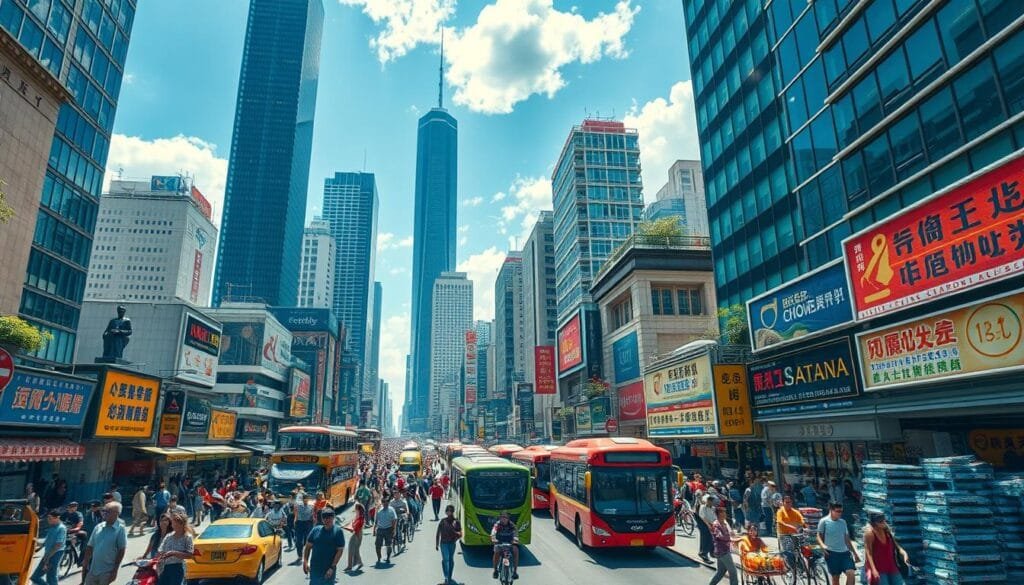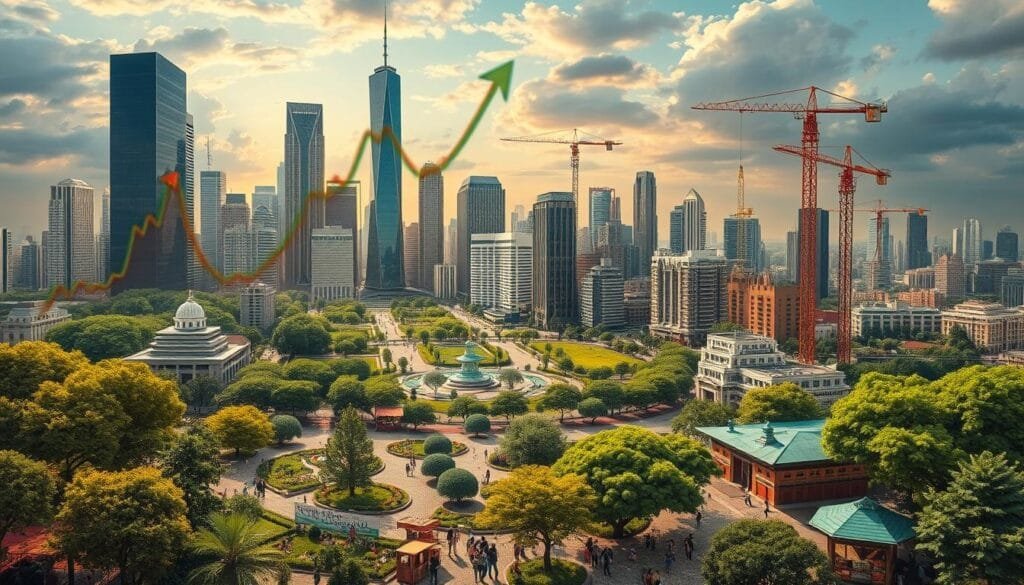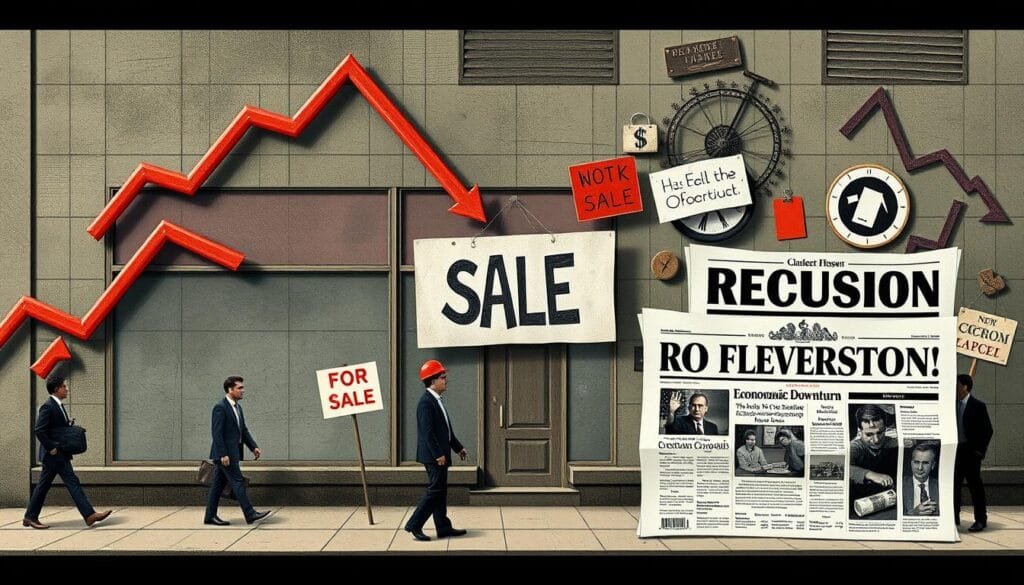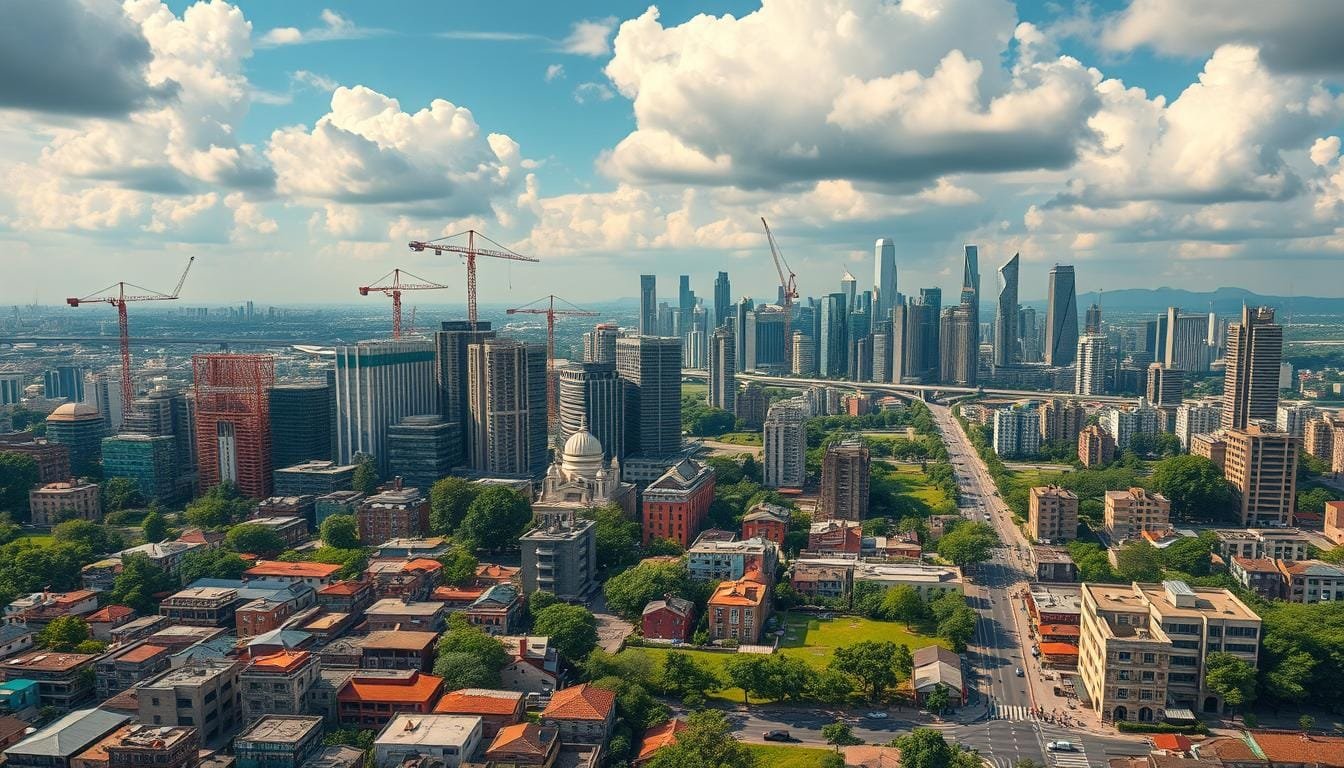What causes the economy to grow or enter a recession? How can we spot these changes through GDP?
The phases of economic growth, such as expansion and contraction, are part of the business cycle stages. These stages greatly affect our GDP. They change employment, how much people spend, and investment choices.
To grasp the economy’s shifts, let’s look at expansion and contraction patterns. During expansion, low interest rates make it easy to borrow money. This leads to more consumer demand and higher production. In this time, jobs and spending go up.
But, when the economy hits its peak, costs and inflation start to rise. This change can lead to contraction. During this time, GDP and economic activities drop. This can cause recession effects on jobs and investing.
Since 1857, economic cycles have seen lots of changes. Contractions have lasted about 18 months on average, while expansions have gone on for about 39 months. Studying these cycles helps us predict market shifts. This way, we can make smart financial choices.
Key Takeaways
- Economic cycles include four phases: expansion, peak, contraction, and recovery.
- During an economic expansion, GDP usually grows around 2% to 3%, with inflation near 2%.
- A two-quarter GDP decline is often seen as a sign of recession.
- In the contraction phase, GDP drops below 2%, affecting profits and jobs.
- Healthcare, consumer staples, and utilities do better when the economy contracts.
- Knowing about business cycle stages helps people make better investment choices, ready for market changes.
Introduction to Economic Cycles
For businesses and policymakers, knowing about economic cycles is key. An economic cycle, or a business cycle, shows how the economy changes over time. These ups and downs are critical for planning and strategizing economically.
What is an Economic Cycle?
The economic cycle has four main stages:
- Expansion
- Peak
- Contraction
- Trough
Each stage has different economic activities. In the expansion phase, jobs and overall economic activity go up. At the peak, economic activity is highest before it starts to drop. Then comes contraction, where spending and demand go down. The trough is the lowest point, with more unemployment and economic worry.
The National Bureau of Economic Research (NBER) identifies these stages. They look at real GDP which shows the true value of goods and services, minus inflation. This helps to understand the economic changes and where we stand in the cycle.
Importance of GDP in Economic Cycles
The role of GDP in economies is huge. GDP shows the health of a nation’s economy by measuring the total value of goods and services produced. It gives us a peek into the wealth and progress of a country. Changes in real GDP are crucial for spotting different economic cycle phases.
In times of expansion, a high GDP means more profit, jobs, and spending. This creates a cycle of growth. However, during contractions, a fall in GDP shows less spending, possible job cuts, and smaller profits. This can mean tighter profits for businesses.
The ups and downs of the economy also affect long-term planning. For example, businesses might grow and hire more during expansions. But in contractions, they might focus on saving costs and becoming more efficient.
| Stage | Characteristics |
|---|---|
| Expansion | Increasing employment, rising GDP, higher consumer spending |
| Peak | Maximum economic output, potential inflation, full employment |
| Contraction | Decreasing GDP, reduced consumer spending, rising unemployment |
| Trough | Lowest point of economic activity, high unemployment |
What is Expansion and Contraction Economics GDP?
Learning about GDP economic phases helps us understand an economy’s health and direction. The terms “expansion” and “contraction” refer to these phases in a nation’s economy.  An expansion phase shows a GDP increase and more economic activities. It leads to more jobs, higher consumer confidence, and rising corporate profits.
An expansion phase shows a GDP increase and more economic activities. It leads to more jobs, higher consumer confidence, and rising corporate profits.
A contraction effects period means the economy is slowing down. It’s seen when real GDP drops for two straight quarters. Cases like the Great Depression and the Great Recession show how contractions cause unemployment and less spending. Governments and businesses have to act wisely during these times to lessen the bad effects.
The following table highlights some notable expansions and contractions in modern U.S. history:
| Period | Phase | Duration | Notable Characteristics |
|---|---|---|---|
| June 2009 – February 2020 | Expansion | ~10 years | Longest economic expansion in U.S. history, characterized by steady GDP growth and low unemployment rates. |
| 1929 – 1941 | Contraction | ~12 years | Great Depression, marked by a severe decline in GDP and extreme unemployment rates. |
| March 2020 – mid-2020 | Contraction | Few months | COVID-19 pandemic caused a sharp and swift economic downturn, with significant job losses. |
| 2007 – 2009 | Contraction | ~2 years | Great Recession, influenced by housing market collapse, led to high unemployment and decreased consumer spending. |
We can better grasp our economy’s cycles by keeping an eye on expansion characteristics and contraction effects. This awareness allows us to make smarter strategies for growth or to counter economic downturns.
Characteristics of Economic Expansion
Economic expansion phases mean the economy is growing and doing well. They show up as economic growth indicators like higher GDP, less unemployment, and more confident consumers. These signs are key to seeing how healthy the economy is.

Indicators of Expansion
GDP goes up during economic growth, showing that the economy is getting bigger. These growth periods usually last from 4 to 5 years. They can be as short as 10 months or longer than a decade. For example, the U.S. had its longest growth period lasting 128 months until February 2020, says the NBER.
There’s also more being made in factories and more shopping during these times. Both of these are important signs of a healthy economy.
Impact on Employment and Wages
When the economy grows, job market improvements happen. This means less unemployment as companies hire more people. Workers also tend to work longer hours in manufacturing jobs during these times.
With more jobs available, wages usually go up. This gives people more money to spend. Then, more spending helps the economy grow even more.
Investment Opportunities during Expansion
Growth periods offer good investment strategies during expansion. Sectors like technology and energy often grow a lot. Businesses feel more confident and spend more on their operations during these times.
Investors see this as a chance to make money. They put their money in areas that are doing well, hoping for big returns.
Understanding Economic Contraction
Economic contraction is marked by a falling GDP, less consumer spending, and more unemployment. It’s a key stage in the business cycle. An economic downturn happens when the real GDP drops for two or more quarters in a row. Spotting recession signs helps us gauge its depth and how long it might last.

Indicators of Contraction
Signs of an economic downturn include dropping prices, slower factory output, and less spending by people. The real GDP, adjusting for inflation, shows our economy’s health. In such times, companies might produce less and lay off employees, leading to more economic woes.
- Declines in consumer spending
- Reductions in business investments
- Decrease in government spending
- Slower manufacturing outputs
Impact on Employment and Wages
The effects on jobs and salaries are big. Companies cutting production means job cuts and no wage increases. Watching unemployment rates gives us a clue about the downturn’s impact. For instance, unemployment hit about 10% in October 2009, showing massive job losses.
“Economic activity hit a peak in February 2020, marking the end of an expansion that lasted 128 months, the longest in U.S. history.”
Historical Examples of Economic Contraction
Looking back at past downturns teaches us about contractions. The Great Depression and the Great Recession are key examples. Both saw huge GDP drops and unemployment spikes. For example, GDP fell by 0.1% in 2008 and 2.5% in 2009, a sharp downturn. Leaders use monetary and fiscal strategies to counter downturns and boost recovery.
| Contraction Period | GDP Decline | Unemployment Peak |
|---|---|---|
| 1929-1933 (Great Depression) | Approx. 30% | 25% |
| 1981-1982 | 1.8% | 10.8% |
| 2007-2009 (Great Recession) | 2.5% | 10% |
It’s vital to know about economic downturns, like recession signs and job trends. Studying past downturns helps us prepare for and lessen future ones. For more on the phases of the business cycle, check out this detailed guide on business cycles explained.
Conclusion
Knowing how the economy grows and shrinks is key to good financial planning. Economic cycles affect jobs, confidence, and spending. Watching changes in GDP, jobs, and consumer habits helps prepare for these shifts. This lets us grab chances when the economy grows and lessen the blow when it shrinks.
History shows us how unpredictable these cycles can be. The Great Depression was the longest downturn in U.S. history. The 2020 COVID-19 recession was short but hit hard. The period from June 2009 to February 2020 was the longest expansion. These examples stress the need for careful planning and awareness.
It’s vital to have strategies for economic changes. Keep an eye on profits, spending, production, and jobless claims. Lower interest rates can boost borrowing and spending in good times. Higher rates in tough times mean being careful. These tactics help us thrive regardless of economic conditions, securing our future.
FAQ
What is an Economic Cycle?
An economic cycle is a series of changes in the economy. It has times of growth and times of shrinking. Understanding these cycles helps us see how economies grow and face downturns. They show trends in jobs, spending, and investment decisions.
Importance of GDP in Economic Cycles
GDP stands for gross domestic product. It’s key to understanding the economic cycles. It shows a country’s total economic output. The NBER uses changes in GDP to figure out the cycle’s stages. Keeping an eye on GDP helps us understand economic ups and downs.
What are the Phases of GDP Economic Growth?
GDP growth goes through expansion, peak, contraction, and trough phases. Expansion means more GDP and economic activities. This leads to growth and more jobs.
Contractions signal a downturn or recession, with a drop in GDP and economic activities. This affects jobs and spending.
What are the Indicators of Economic Expansion?
Signs of expansion include a higher GDP, lower unemployment, and more corporate profits. This phase boosts industrial output, customer demand, and stock markets. These signs point to a strong economy with better job chances and pay raises.
How Does Economic Expansion Impact Employment and Wages?
In expansion times, more jobs appear, leading to improved wages. Better consumer confidence boosts businesses and job markets.
Investment Opportunities during Economic Expansion
Expansions are a good time to invest, especially in tech, capital goods, and energy sectors. These areas often thrive when GDP is going up, making investments wise during these growth times.
What are the Indicators of Economic Contraction?
Signs of contraction are a falling GDP, less spending, and more unemployment. These times can signal a recession. They show in falling prices and a production slowdown, affecting the economy’s health.
Impact of Economic Contraction on Employment and Wages
Contractions often lead to fewer jobs and static wages. The dip in economic activities raises unemployment and dampens consumer trust, hurting job markets and wages.
Historical Examples of Economic Contraction
The Great Depression and the 2007-2009 Great Recession are major economic downturns. They caused widespread job losses and hardship. These times often need government steps to help recovery and support workers.
